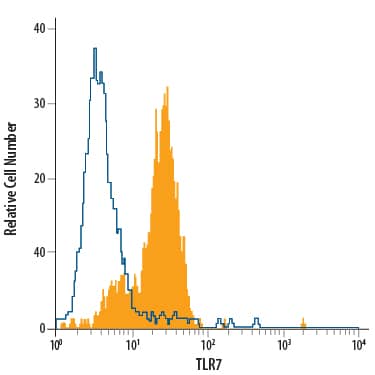Human TLR7 PE-conjugated Antibody
R&D Systems, part of Bio-Techne | Catalog # IC5875P


Conjugate
Catalog #
Key Product Details
Species Reactivity
Validated:
Human
Cited:
Human
Applications
Validated:
Intracellular Staining by Flow Cytometry
Cited:
Flow Cytometry, Immunohistochemistry-Frozen
Label
Phycoerythrin (Excitation = 488 nm, Emission = 565-605 nm)
Antibody Source
Monoclonal Mouse IgG2A Clone # 533707
Product Specifications
Immunogen
E. coli-derived recombinant human TLR7
Met360-Leu516
Accession # Q9NYK1
Met360-Leu516
Accession # Q9NYK1
Specificity
Detects human TLR7 in direct ELISAs.
Clonality
Monoclonal
Host
Mouse
Isotype
IgG2A
Scientific Data Images for Human TLR7 PE-conjugated Antibody
Detection of TLR7 in Ramos Human Cell Line by Flow Cytometry.
Ramos human Burkitt's lymphoma cell line was stained with Mouse Anti-Human TLR7 PE-conjugated Monoclonal Antibody (Catalog # IC5875P, filled histogram) or isotype control antibody (Catalog # IC003P, open histogram). To facilitate intracellular staining, cells were fixed with Flow Cytometry Fixation Buffer (Catalog # FC004) and permeabilized with Flow Cytometry Permeabilization/Wash Buffer I (Catalog # FC005). View our protocol for Staining Intracellular Molecules.Detection of Human TLR7 by Flow Cytometry
Gating strategy for the detection of TLR-7 and -9 in B cell subsets.PBMC were isolated from whole blood and stained for surface markers before cells were fixed, permeabilised and stained for TLR-7 and -9. FSC and SSC were first used to gate out debris (A) and SSC-A and SSC-H was utilized to eliminate duplicates (B). Further gating was done on CD45 and CD19, to target B cells (C). To separate between the different B cell populations, we gated on CD27 and IgD (D), followed by TLR-7 and -9 expression on these subsets (E). Data from one representative patient is shown. Image collected and cropped by CiteAb from the following publication (https://dx.plos.org/10.1371/journal.pone.0120383), licensed under a CC-BY license. Not internally tested by R&D Systems.Applications for Human TLR7 PE-conjugated Antibody
Application
Recommended Usage
Intracellular Staining by Flow Cytometry
10 µL/106 cells
Sample: Ramos human Burkitt's lymphoma cell line fixed with Flow Cytometry Fixation Buffer (Catalog # FC004) and permeabilized with Flow Cytometry Permeabilization/Wash Buffer I (Catalog # FC005)
Sample: Ramos human Burkitt's lymphoma cell line fixed with Flow Cytometry Fixation Buffer (Catalog # FC004) and permeabilized with Flow Cytometry Permeabilization/Wash Buffer I (Catalog # FC005)
Reviewed Applications
Read 1 review rated 4 using IC5875P in the following applications:
Formulation, Preparation, and Storage
Purification
Protein A or G purified from hybridoma culture supernatant
Formulation
Supplied in a saline solution containing BSA and Sodium Azide.
Shipping
The product is shipped with polar packs. Upon receipt, store it immediately at the temperature recommended below.
Stability & Storage
Protect from light. Do not freeze.
- 12 months from date of receipt, 2 to 8 °C as supplied.
Background: TLR7
Long Name
Toll-like Receptor 7
Alternate Names
toll-like receptor 7
Gene Symbol
TLR7
UniProt
Additional TLR7 Products
Product Documents for Human TLR7 PE-conjugated Antibody
Product Specific Notices for Human TLR7 PE-conjugated Antibody
For research use only
